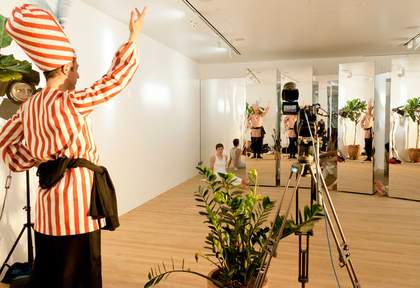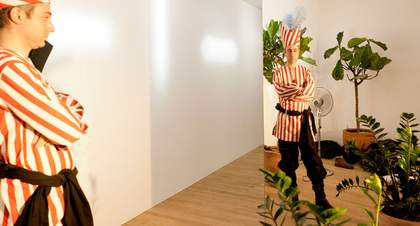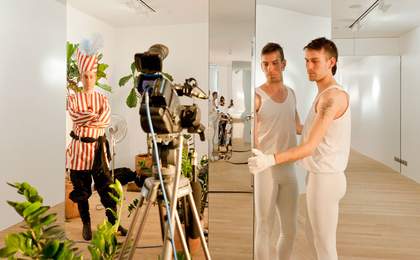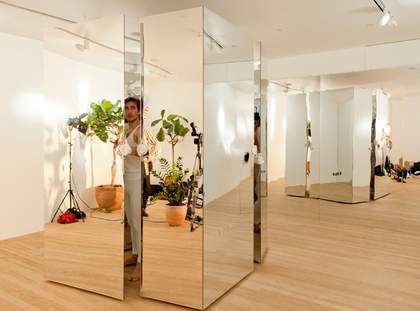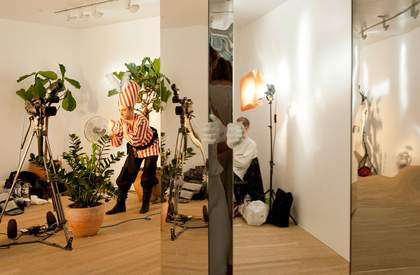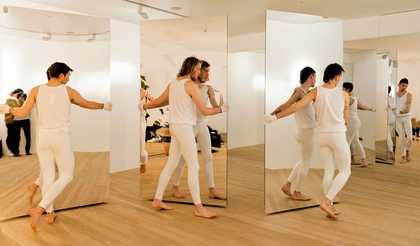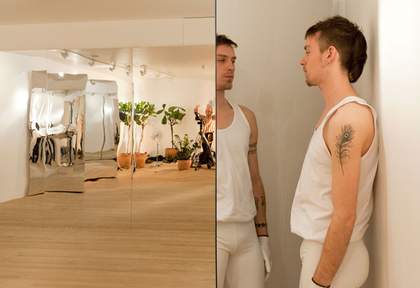Constantinople Kaleidoscope was a performance by the Argentinian artist Pablo Bronstein created for BMW Tate Live: Performance Room. Interested in the intersection between architecture, choreography and visual art, Bronstein explored in this work these different creative practices through the physical space of the McAulay Gallery at Tate Modern and the online space of the Performance Room.
Four dancers – Luke Birch, Martin Collins, Erik Nevin and Rosalie Wahlfrid – performed a sequence of movements choreographed by Matthias Sperling. Each was dressed in white and wore a pair of white cotton gloves. Each dancer moved a mirrored prism that stood taller and wider than the dancers and so obscured them at certain angles. The back wall of the gallery was also clad in mirrored panels, which made the room seem much bigger. Following the choreography the dancers moved the mirrored panels, which were set on casters, in different configurations. Sometimes the objects were rotated individually, at other times they were brought together in specific patterns. At one point the panels formed a mirrored cube, which obscured everything apart from the dancers’ gloved hands. Meanwhile Bronstein occupied a corner of the room, dressed in the style of an Ottoman-era Turkish prince, in a red-and-white striped costume designed by Clea Broad and surrounded by potted plants. Bronstein moved slowly between static poses as if posing for a portrait of the historical figure he represented.
The staging of Constantinople Kaleidoscope resembled an intricate, baroque court performance for an anonymous prince. In this spectacle the mechanism of the kaleidoscope was exploded, collapsing the architecture of the room into a series of overlapping images. This gestured to trompe l’oeil, a technique which has been used for centuries in painting and sculpture as well as in theatre design to create the illusion of space. Here, rather than make the space seem bigger, the moving mirrored columns fragmented the space and disturbed the viewer’s perception and understanding. This confusion also gestured to the transmission of the work through internet live-streaming, which can only offer a representation of the space and the performance within it. Indeed this was emphasised by the presence of the camera in the mirror reflections, which served as a reminder to the viewer of this mediated encounter. In this way, the image of the performance – both recorded and reflected – as well as the mechanisms that transmitted and animated them (the camera and the choreographed dancers) form parts of the work.
Constantinople Kaleidoscope interrogated the different kinds of space, physical and digital, mobilised in the Performance Room programme. The series offered invitations to artists to create a one-time performance to be live-streamed from Tate Modern through Tate’s YouTube channel around the world. There was no ‘live’ audience present in the room during the performance, but online viewers could see the performance as it happened, interact with one another through social media channels and pose questions during a subsequent online question and answer session. The live-stream of the work and the discussion were digitally archived on Tate’s YouTube channel and website, where it is available for viewing anywhere and at any time after the initial performance.
Acatia Finbow
October 2015

